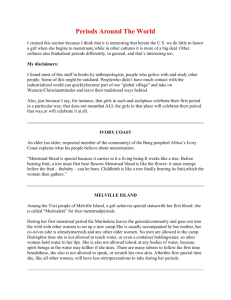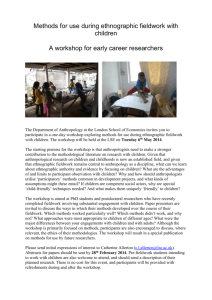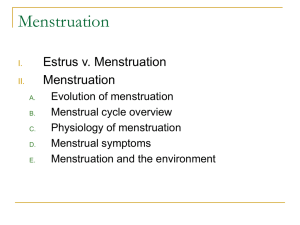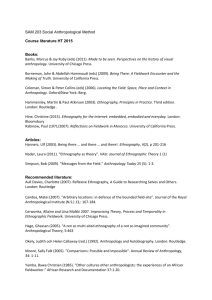Case Study - Association of American Colleges
advertisement
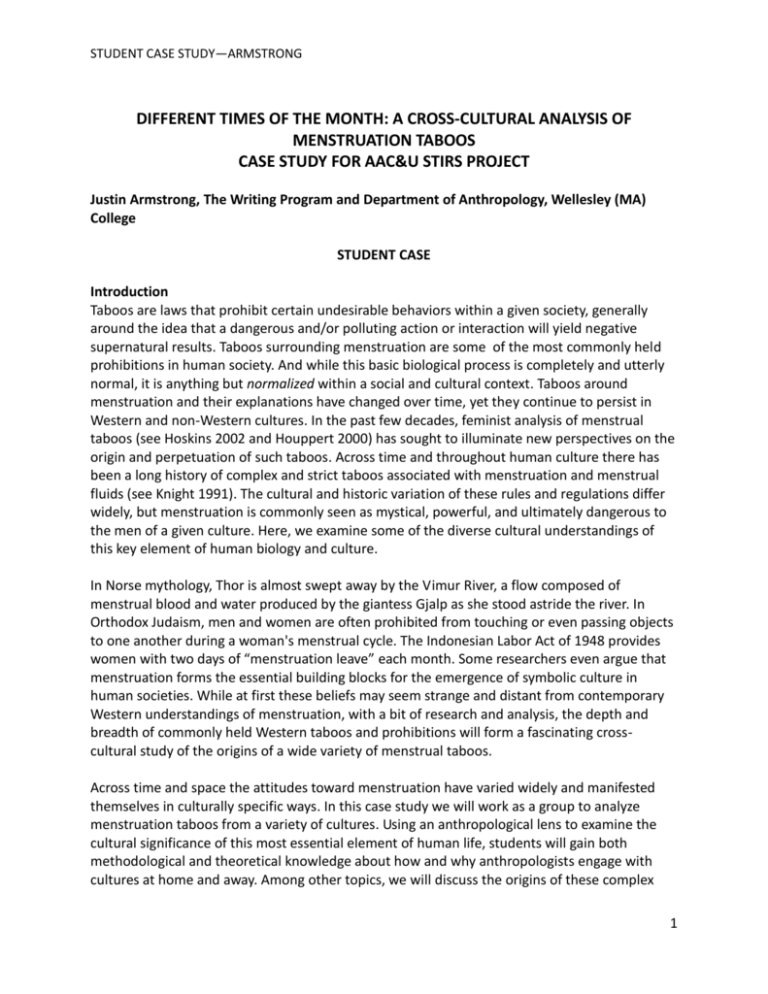
STUDENT CASE STUDY—ARMSTRONG DIFFERENT TIMES OF THE MONTH: A CROSS-CULTURAL ANALYSIS OF MENSTRUATION TABOOS CASE STUDY FOR AAC&U STIRS PROJECT Justin Armstrong, The Writing Program and Department of Anthropology, Wellesley (MA) College STUDENT CASE Introduction Taboos are laws that prohibit certain undesirable behaviors within a given society, generally around the idea that a dangerous and/or polluting action or interaction will yield negative supernatural results. Taboos surrounding menstruation are some of the most commonly held prohibitions in human society. And while this basic biological process is completely and utterly normal, it is anything but normalized within a social and cultural context. Taboos around menstruation and their explanations have changed over time, yet they continue to persist in Western and non-Western cultures. In the past few decades, feminist analysis of menstrual taboos (see Hoskins 2002 and Houppert 2000) has sought to illuminate new perspectives on the origin and perpetuation of such taboos. Across time and throughout human culture there has been a long history of complex and strict taboos associated with menstruation and menstrual fluids (see Knight 1991). The cultural and historic variation of these rules and regulations differ widely, but menstruation is commonly seen as mystical, powerful, and ultimately dangerous to the men of a given culture. Here, we examine some of the diverse cultural understandings of this key element of human biology and culture. In Norse mythology, Thor is almost swept away by the Vimur River, a flow composed of menstrual blood and water produced by the giantess Gjalp as she stood astride the river. In Orthodox Judaism, men and women are often prohibited from touching or even passing objects to one another during a woman's menstrual cycle. The Indonesian Labor Act of 1948 provides women with two days of “menstruation leave” each month. Some researchers even argue that menstruation forms the essential building blocks for the emergence of symbolic culture in human societies. While at first these beliefs may seem strange and distant from contemporary Western understandings of menstruation, with a bit of research and analysis, the depth and breadth of commonly held Western taboos and prohibitions will form a fascinating crosscultural study of the origins of a wide variety of menstrual taboos. Across time and space the attitudes toward menstruation have varied widely and manifested themselves in culturally specific ways. In this case study we will work as a group to analyze menstruation taboos from a variety of cultures. Using an anthropological lens to examine the cultural significance of this most essential element of human life, students will gain both methodological and theoretical knowledge about how and why anthropologists engage with cultures at home and away. Among other topics, we will discuss the origins of these complex 1 STUDENT CASE STUDY—ARMSTRONG narratives and beliefs about a basic element of human reproduction. We will ask why menstruation is one of the most stigmatized aspects of human biology and culture. Why are we repulsed, ashamed, fascinated, afraid, and secretive about this natural process? Here, biology and culture intersect to provide a unique illustration of the origin and function of taboos. Timeline The initial case study will take place over the course of two weeks (four class meetings) with the ethnographic fieldwork component extending over the entire semester. Learning Objectives (with disciplinary/topical applicability) 1. Describe key elements of the ethnographic method (including participant–observation) (anthropology, sociology, cultural studies) 2. Implement basic methods used by cultural anthropologists to collect and analyze field data (anthropology, sociology) 3. Examine the role of menstruation taboos in both cultural and historical contexts (anthropology, history, women and gender studies) 4. Discuss the intersection between biological and cross-cultural understandings of taboo (human biology, anthropology) 5. Critically analyze academic writing in social sciences and humanities (anthropology, English, sociology, general social sciences) 6. Articulate a concrete understanding of the process of cross-cultural comparison (anthropology, sociology) 7. Create workable, engaging thesis statements for writing papers in social science (social science, writing, English) 8. Implement improved writing and research skills in a social science setting (social science, writing, English) Preparation (before coming to class) Carefully review the introductory materials listed below. Each reading offers a brief, easily digestible introduction to the subject of each part of the case study. Part One —American Ethnography Quasimonthly. 2011. “What Is Ethnography?” Available at: http://www.americanethnography.com/ethnography.php. Part Two—Matthiesson, M. 2013. “From Menstrual Huts to Drinking Blood—The Weird and Wacky World of Cultural Attitudes toward Menstruation, Part 1.” Blog, Rubycup.com, April 17, 2013. Available at: http://ruby-cup.com/blog/. Part Three—George, R. 2012. “The Taboo of Menstruation.” New York Times, December 28, http://www.nytimes.com/2012/12/29/opinion/the-taboo-of-menstruation.html?_r=0. Part Four—Ghodsee, K. 2013. “Writing Ethnographies that Ordinary People Can Read.” Anthropology News, 54(5). 2 STUDENT CASE STUDY—ARMSTRONG In each of the above sections you will find a brief overview of the topics that we will cover in class. Please make sure that you've read the assigned readings for each part of the case before the class meeting. Part One: People Studying People—The Practice of Ethnography in Context What is ethnography, and how can it help us to better understand the cultural significance of menstruation? This section of the case study contains: a concise introduction to cultural anthropology, an outline of ethnographic methods, and a discussion of ethics in anthropological fieldwork. Ethnography is the term anthropologists use to describe the written product of field research and the subsequent analysis of that data. Ethnography is also the careful exploration of cultural phenomena of a given group of people using the practice of participant–observation (see below). It often involves extended stays in a particular location to allow the anthropologist to gain a deep and intimate understanding of the people he or she is studying. At its core, ethnography is the translation of the anthropologists’ experiences in the field for nonanthropologists. It is also important to note that increasingly, anthropologists have been practicing their discipline in their own backyards, drawing out local and regional cultures that can be just as unique and engaging as those that are more distant and seemingly exotic. Cultural anthropology asks—and hopefully answers—why we do the things we do as human beings, offering insight into why a particular practice occurs in a particular time and place. It presents a new kind of understanding about how we structure our symbolic world. Ethnographers undertake this project by engaging in what is known as participant–observation, meaning that they embed themselves in a culture by actively participating in it. This form of active participation involves three key elements: living in the culture, learning the language, and participating in the everyday life of the community. This method of engagement is essential to anthropologists because without this sort of intimate knowledge of their subjects their ethnographies would lack an interpretive dimension. While they are doing what their subjects do they are also taking detailed field notes, shooting photos, and conducting interviews (as well as culling information from everyday conversations) to gain a more in-depth understanding of the culture they are studying. Discussion and Research Questions to Consider A) B) Is the presence of menstruation taboos culturally universal? How does symbolism play into understandings of menstruation cross-culturally? What is ethnography, and how can it help us to better understand attitudes toward menstruation? How might the practice of ethnography be useful in other disciplines and situations? 3 STUDENT CASE STUDY—ARMSTRONG C) What role do ethics play in ethnography? What ethical dilemmas might anthropologists researching this topic encounter, and how might they navigate these situations? How can interviews and other interactions be tailored to accommodate culturally specific attitudes toward menstruation? Many valuable resources on ethics in anthropological fieldwork can be found at the AAA Ethics Blog (http://ethics.aaanet.org/). Part Two: Menstruation across Time and Space What are the cross-cultural understandings of menstruation, and why is it such a significant and powerful taboo? How and why do attitudes differ throughout history and across cultures? This section of the case study contains: a working definition of cross-cultural comparison and a cultural history of menstruation. One of the key elements of an anthropologist's methodological toolkit is cross-cultural comparison. This process of careful inquiry asks how different cultures understand similar phenomena. In our case study, we'll be looking at how cultures throughout history and around the world have understood and continue to understand the cultural significance of menstruation. We'll also be examining the anthropological definition of taboo as a functional element of culture with a specific focus on menstruation taboos. As part of this exploration, we'll also be discussing the use of a culturally relative approach (the idea that anthropologists should not judge other cultures based on the values, morals, and ideals of their home culture) to ethnographic research, especially as it relates to the study of sometimes sensitive subjects such as menstruation, bodily functions, and reproduction. It is important to note that cultural relativism has its limitations, and that an anthropologist can never be fully relativistic in his or her approach to another culture—here, it is all about balancing and managing cultural relativism in the field. Discussion and Research Questions to Consider A) B) C) How do anthropologists use cross-cultural comparisons to understand cultural structures and functions? What are the benefits and drawbacks of using cross-cultural comparison? How can anthropologists use cross-cultural comparison to better understand taboos and their function within societies? What purpose do they continue to serve in cultures around the world? How has menstruation been documented across time and culture? How has the social and cultural history of menstruation been written, and by whom? How do cultural texts shape our view of natural/biological phenomena? What is cultural relativism? How and why should anthropologists be culturally relative in their approach to studying traditionally taboo topics such as menstruation? What are the social and cultural limits of ethnographic inquiry? Part Three: Blood, Sex, Magic 4 STUDENT CASE STUDY—ARMSTRONG What cultural function do menstruation taboos serve? This section of the case study contains: definitions of the social and cultural function of taboos; an examination of specific menstruation taboos from around the world; and discussion and analysis of various media and artistic portrayals of menstruation across time and space. For many anthropologists, the concept of functionalism (the ways that culture satisfies and sustains biological needs) is useful in understanding how and why certain cultural practices emerge, are maintained, and sometimes fade away. Here, we'll be analyzing the function of taboos around menstruation as a means of analyzing the larger idea of taboos around what anthropologist Mary Douglas (1966) has called “purity and danger.” To better understand the origins and functions of these kinds of taboos, we'll be examining a number of culturally specific menstruation taboos, including examples from cultures in North America, Africa, Asia, the Middle East, and Oceania. Additionally, we'll examine the way that menstruation has been imagined, defined, and stigmatized in various media. Looking across cultures and histories, we'll review literary, cinematic, and artistic portrayals, as well as focusing our ethnographic eye on advertisements, public service announcements, and “feminine hygiene products.” Discussion and Research Questions to Consider A) B) What are some contemporary taboos from your home culture, and what function do they serve? What are the symbols contained within these taboos? What are some of the possible origins of these taboos? How are they changing with broader changes in the surrounding culture? How and why has the media/art world portrayed menstruation in the way that it has? What are some of these portrayals? How have films, advertising, and digital media changed our relationship to menstruation and other taboo subjects? Are these representations problematic or proactive? Why/why not? Part Four: In the Field A) B) IV.C How can we apply the ethnographic research method to other realms of culture? What other disciplinary lenses could we use to study menstruation taboos? How would using a different approach change our inquiry and conclusions? What will you do with your findings? How will translate your research into readable, relatable writing (an ethnography)? This section of the case study prepares you for direct engagement in real-world ethnographic fieldwork through: 5 STUDENT CASE STUDY—ARMSTRONG developing interview questions/models, conducting ethnographic research on attitudes toward menstruation in your home community, and analyzing your data and presenting your research findings. This case study offers you a chance to directly engage with ethnographic fieldwork by conducting your own small-scale ethnographic research project. Here, you are given the opportunity to design and implement your own research project to gain a better understanding of how anthropologists work in the field, as well as to gain new insight into the prevailing attitudes toward menstruation in your own community. In class, you will conduct practice interviews with classmates and learn the ins and outs of ethnographic fieldwork, including taking detailed field notes, gaining informed consent, and structuring useful interview questions. In small groups, you will brainstorm research topics, edit research proposals, and discuss ethical issues that may arise in the field. As a group, you will develop a concrete research question and work together to collect (through observations and participant–observation) and analyze your ethnographic data. Once Part Four has been completed, you will continue to work on your group research projects for the remainder of the semester with regularly scheduled “check-ins” with other members of the group and the instructor. During the last week of the semester, you'll present your findings to the class. After reading the associated articles in the Course Pack and discussing them in class (your instructor and the articles will provide a working outline of ethnographic methods, theory, and ethics), you should have a clear understanding of how to take field notes, gain informed consent, and conduct meaningful interviews. The first step in developing a research question is to meet with your group (the instructor will assign you to a group with two other students) and brainstorm research topics that you might be interested in addressing in your research. Consider any and all of the topics we've already covered in the case study. Think about what makes an interesting focus for research and what topic will yield the most engaging results. What would you want to know about as a reader of this ethnographic study? What can you realistically accomplish in the timeframe of this mini-ethnography? Who will be your subjects? Do you have access to them? What sort of ethical and logistical issues might arise, and how might you mediate them? Think about how your group will present their findings—perhaps you'd like to include video, audio, and/or photos in your ethnography. Once you've decided on a topic and research question, you'll need to figure out how you're going to collect your data. Who will you interview? Where will you find them? How will you find them? As a group (and in conversation with your instructor), discuss how and where you'll be collecting your data. With this information in hand (and the methodological toolkit provided by the readings and class lectures/discussions), you can now head out into the field to unearth the answers to your ethnographic questions. 6 STUDENT CASE STUDY—ARMSTRONG After you've collected your data, as a group, you'll need to discuss how you're going to produce meaningful, relatable, and interesting analysis out of it. Your instructor will outline how you might go about analyzing the data, and the Appendix of this case study offers some guidance in thinking through your findings and turning them into an engaging mini-ethnography. Now all that's left is to present your findings to the rest of the class in a short (10–15 minute) presentation. Discussion and Research Questions to Consider IV.A What fieldwork methods were helpful/unhelpful in collecting your research data? IV.B What changed about your approach to your project from the classroom to the field? IV.C What ethical, social, and/or cultural challenges did you face in conducting this research? IV.D What will you do with your findings? How will you translate your research into readable, relatable writing (an ethnography)? References Brown, D. 1991. Human Universals. New York: McGraw-Hill. Buckley, T. C. T., and A. Gottlieb. 1988. Blood Magic: The Anthropology of Menstruation. Berkeley: University of California Press. Delaney, J., M. J. Lupton, and E. Toth. 1988. The Curse: A Cultural History of Menstruation. Urbana: University of Illinois Press. Douglas, M. 1991. Purity and Danger: An Analysis of the Concepts of Pollution and Taboo. London: Routledge. Frame, J., J. Rosenblatt, and Jay Rosenblatt Film Library. 1996. Period Piece. Ho-Ho-Kus, NJ: Locomotion Films. Freud, S. 1918. Totem and Taboo. New York: Moffat Yard. M. Guterman, P. Mehta, and M. Gibbs. 2007. “Menstrual Taboos among Major Religions.” Internet Journal of World Health and Societal Politics, 5(2). Hoskins, J. 2002. “The Menstrual Hut and the Witch's Lair in Two Eastern Indonesian Societies.” Ethnology, 41(4): 317–33. Houppert, K. 1999. The Curse: Confronting the Last Unmentionable Taboo: Menstruation. New York: Farrar, Straus, and Giroux. Grahn, J. 1993. Blood, Bread, and Roses: How Menstruation Created the World. Boston: Beacon. 7 STUDENT CASE STUDY—ARMSTRONG Knight, C., C. Power, and I. Watts. 1995. “The Human Symbolic Revolution: A Darwinian Account.” Cambridge Archaeological Journal, 5(1): 75–114. Knight, C. 1991. Blood Relations: Menstruation and the Origins of Culture. New Haven, CT: Yale University Press. Laws, S. 1990. Issues of Blood: The Politics of Menstruation. Houndmills, Basingstoke, Hampshire: Macmillan. MacPhee, M. 2012. Vulnerability and the Art of Protection: Embodiment and Health Care in Moroccan Households. Carolina Academic Press. Olesen, V. L., and N. F. Woods. 1986. Culture, Society, and Menstruation. Washington: Hemisphere Publishing Corporation. Owen, L. 1993. Her Blood Is Gold: Celebrating the Power of Menstruation. San Francisco: Harper San Francisco. Sievert, L. 2006. Menopause: A Biocultural Perspective. Newark, NJ: Rutgers University Press. Shail, A., and G. Howie. 2005. Menstruation: A Cultural History. Basingstoke, Hampshire England: Palgrave Macmillan. Stein, E., and S. Kim. 2009. Flow: The Cultural Story of Menstruation. New York: St. Martin's Griffin. Steinem, G. 1995. “If Men Could Menstruate.” In Outrageous Acts and Everyday Rebellions, 366–69. New York: Holt Paperbacks. 8 STUDENT CASE STUDY—ARMSTRONG Appendix―A Student Guide to Mini-Ethnography In this assignment you are going to be conducting research to produce a mini-ethnography that examines the prevailing cultural attitudes toward menstruation. You will be working in pairs to collect your data, but you will each write and submit your own mini-ethnography. Start with a question about menstruation taboos drawn from our class discussions and readings. Make sure it's something that you feel comfortable discussing with your potential informants. Collect interesting stories, remembrances, and family/cultural histories from your informant(s). Make sure to tell your informants that you'll be assigning them pseudonyms to protect their identities (a standard practice in ethnographic fieldwork). You might want to ask someone from a different culture than yours to tell you about their experiences and/or social/cultural views of menstruation; interview some of your peers; maybe you'd like to develop a survey; you could even interview people from different generations to learn about changing attitudes across time and culture. You could also examine the particular rituals, myths, and histories of a certain culture's view of menstruation and then compare your findings to your informants' responses. What can we learn about American culture by examining prevailing attitudes toward menstruation? What different social and cultural patterns/practices can you 'read' through these attitudes? These ideas are only a start; if you'd like to try something else, let me know and we'll make it work. In this assignment you are creating an engaging piece of writing that tells the reader something meaningful about prevailing and changing cross-cultural understandings of menstruation. Ask yourself why your reader would want to know the things that you're telling them. Remember to follow-up on responses from your subject by asking “How so?” and “Can you elaborate on that point a bit?” As discussed/outlined in previous course material on this method, try to avoid inserting your own opinion into the interview/participant-observation component of your ethnography—you should be a good listener and record as many details as possible in order to help create a rich, thick description of your subject(s). It is also important to gauge whether or not your subjects are comfortable with your presence or with being interviewed—if anyone is hesitant to participate, please be respectful and find someone else with whom to work. Finally, make sure to provide the necessary context for your findings by including a clear thesis supported by historical and/or anthropological evidence for your claim. If, for example, you've decided to examine the connection between advertising and changing attitudes toward menstruation, make sure to include some background information to help your reader understand the cultural context and social significance of your study. Students should also consult the American Anthropological Association's Code of Ethics (http://ethics.aaanet.org/category/statement/) for a detailed examination of the ethics of conducting ethnographic research. 9 STUDENT CASE STUDY—ARMSTRONG About the Author Justin Armstrong's current research is situated primarily in cultural geography and human ecology, ethnographic perspectives on globalization, and the anthropology of space and place. His doctoral research examined the unique cultural geography of near-abandoned and isolated farming communities (i.e., almost “ghost towns”) throughout the North American High Plains (North Dakota, Saskatchewan, and Wyoming) and the Atlantic coast (Maine and Newfoundland). Specifically, he examined how a sense of place, or the idea of home, is (or is not) maintained in these spaces through local histories, particularly in light of increased globalization and rural–urban migration. In recent years, his research has expanded to include Iceland and the Faroe Islands. Armstrong teaches writing and anthropology at Wellesley College in Wellesley, MA. He received a BA in cultural anthropology from Wilfrid Laurier University (Waterloo, ON) and a MA and PhD in cultural anthropology from McMaster University (Hamilton, ON). He was born in Saskatchewan, raised in northern Ontario, and lives in Boston. 10




